
The highlight of the 4-day Salkantay Trek to Machu Picchu is the opportunity to walk in the shadow of the snow-capped Salkantay Mountain (6,264 meters).
Unlike the classic 3-day Inca Trail trek, which requires you to book a spot at least five to six weeks in advance (in the low season), the Salkantay Trek can be booked in Cusco upon arrival.
And it can be done for less than half the cost. I'll be writing more about how to book the trek and what to pack in future posts.
But first, I want to take you through the journey day by day, as it was an authentic outdoor adventure that tested both my mental and physical resolve.
Day 1 – Cusco to Soraypampa
Begin: Mollepata 2,900 meters / 9,514 feet; End: Soraypampa 3,900 meters / 12,795 feet
Change in Elevation: 1,000 meters / 3,281 feet
Time walking: 5 hours 15 minutes
Awake at 4 AM, I wiped the sleep from my eyes, rolled out of bed, and moved my bags to the hostel reception.
As expected, it wasn't until about 4:30 – 4:40 AM that the minivan pulled up.
Under cover of darkness, we drove around, picking up additional trekkers. Our group for the next five days was slowly forming.
Abhishek, a young British doctor. A young German doctor. Two Dutch girls. Nicole (Canada). Two Malaysian women in their 40's. A young Japanese guy.
And Kathy, an older Australian woman who had just completed the Inca Trail the day before (she did the two treks back to back).
The sky began to brighten as we drove from Cusco to Mollepata, a small pueblo, where we had a simple breakfast of bread and eggs with mate de coca (coca tea).
Afterward, we were led to a large truck, in which we hitched a ride for several kilometers up a steep, muddy road.
Our guide would say it saved us a few hours of walking. Nobody protested.
Once the truck dropped us off, we began our walk straight up the mountainside.
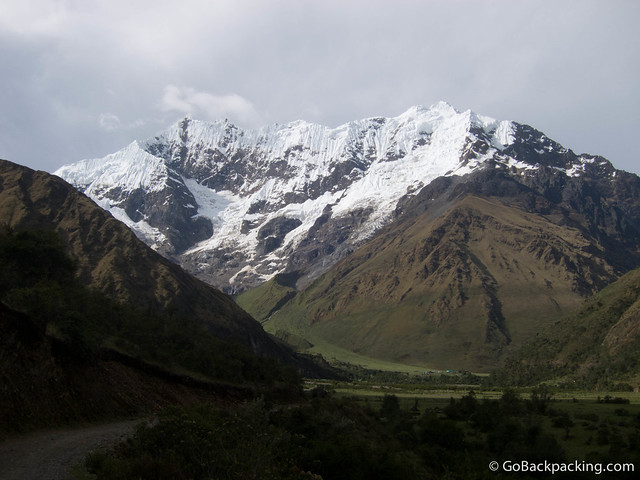
I had given myself five nights to acclimatize in Cusco, which sits at 3,300 meters above sea level, but I'd failed to do any exercise during that time.
My heart was pounding within the first few minutes.
One of the Malaysian women, both of whom had been to Everest Base Camp and successfully climbed Mt. Kilimanjaro two years earlier, complained of a headache.
I knew if she was feeling bad at 3,100 meters before we'd even started, it wasn't going to bode well for her that night or on Day 2, the most challenging day of the trek.
The sun was beating down; it was hotter than I'd expected.
Covered in a familiar layer of suntan spray and mosquito repellent, I tried to settle into a comfortable walking rhythm.
Over three years had passed since my last high-altitude trek to Indrahar Pass in northern India. I hadn't realized it'd been so long since I gave myself a good physical challenge.
Doubts began creeping into my head. They were familiar ones about my health at high altitudes and physical stamina.
I recognized them from my Annapurna Sanctuary trek in Nepal, the one where I didn't reach Base Camp, an experience on the whole that took me months to get over.
After two and a half hours of walking, we stopped for lunch: soup and a rustic version of lomo saltado (beef, vegetables, and rice).
Despite knowing food is energy, I barely finished half my plate, and I needed as much as possible. I relied on chocolate and copious amounts of water instead.
I probably drank two to three times more water throughout the trek and pissed two to three times more often than anyone else in our group.
Sitting at the table, mind filled with doubts about whether I was fit for this trek, one of the Dutch girls said something that snapped me back into reality.
Paraphrasing, she said any of us can do this trek if we want it. I wanted it. Badly.
And from that point forward, I walked with renewed vigor. As if I'd been asleep at the wheel those first few hours, and I was suddenly awake.
Instead of allowing my thoughts to run wild with fear, I took control of my mind, and thus, my body followed suit.

After lunch, we were looked up the valley to see the glacier-covered Umantay.
Unlike some trekkers, I gain energy by seeing the next camp — the next destination.
Almost two hours later, I walked into our campsite for the night.
We helped the cook and horseman pitch the tents in an area protected by a sheet metal roof and plastic tarp walls.
It wasn't much, but it'd help keep the wind out and keep us dry if it rained.
It was my first time sleeping at an altitude as high as 3,900 meters (12,795 feet).
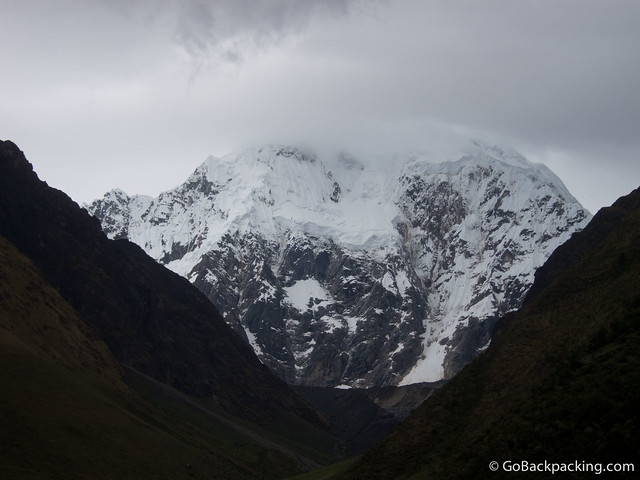
We all scarfed down the popcorn served as an appetizer.
I forgot the main course, but it was much better than lunch, as was the case with the meals on the remainder of the trek, thankfully.
By 10 PM, we were all in our sleeping bags. Day 2 was going to be the longest, most challenging day of the trek, and we'd be getting an early start.
I woke up once in the middle of the night to pee. On the walk back to the tented area, I took a moment to stop and turn off my headlamp.
Total darkness.
I craned my neck up and looked at the star-filled sky.
The kind of bright stars you only see when you take the time to physically remove yourself from the modern world.
Day 2 – Soraypampa to Chaullay
Begin: 3,900 meters / 12,795 feet; High Point: 4,650 m / 15,256 ft; End: 2,900 m / 9,514 ft
Change in Elevation: +750 m / +2,461 ft uphill; followed by: -1,750 m / 5,741 ft downhill
Time walking: 8 hours 15 minutes
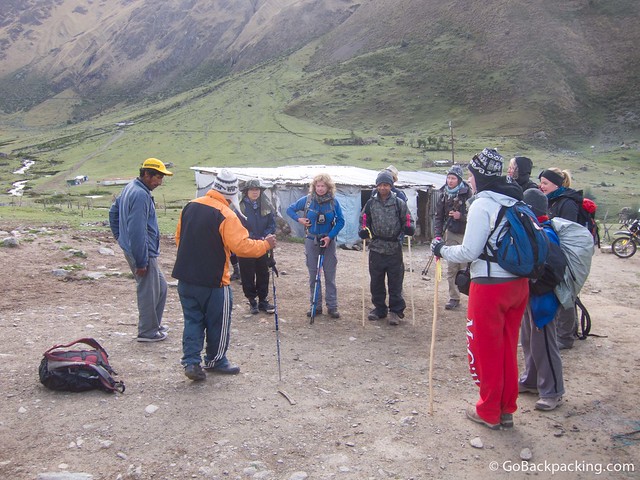
Day 2 started with a 5 AM wake-up call and a cup of coca tea.
By the time we'd eaten breakfast, the sun was already reflecting brightly off the glaciers around us.
Our guide, Daniel, took a few minutes to introduce the support crew, including a cook, assistant cook, and horseman who managed the horses that carried our camping equipment, food, gas, and supplies.
I had a relatively good night's sleep. It wasn't the most comfortable, as the sleeping mat provided was paper-thin, but my rented sleeping bag was sufficiently warm, which was what mattered most.
I bought some extra chocolate and water. I think I walked out of camp with 3.25 liters of water in my bag, if not a little more.
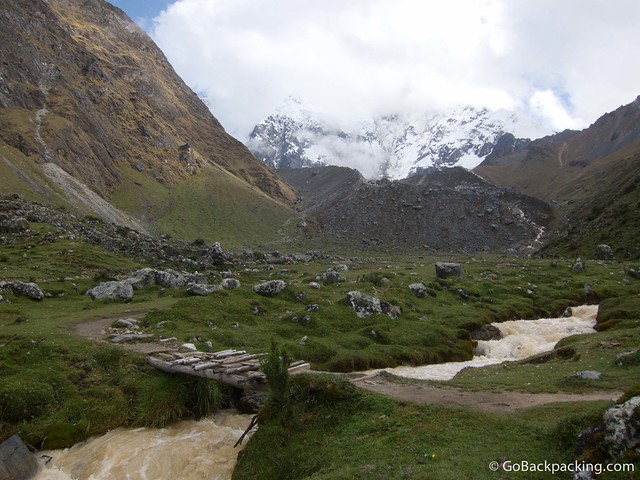
We began making our way up the valley toward Salkantay Mountain, which would remain partly shrouded in clouds the whole morning.
The day before, we got a glimpse of the peak both on the drive to Mollepata and from Camp 1, which was enough to satisfy me, given we were there in the off-season.
Kathy, the Australian woman, shared some coca leaves with us, along with a natural “accelerator” that speeds up the effects when combined with the leaves.
Within a minute or two of chewing on the leaves, the right side of my tongue went numb.
Spitting out the juices, as if I were chewing on tobacco, was less than appealing, so eventually, I spit out the whole wad of masticated leaves.
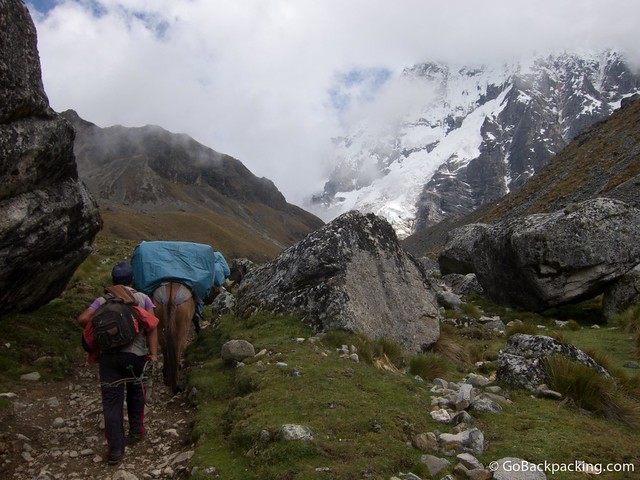
Refocusing on the trail, the views continued to get prettier and prettier as our hearts beat harder and harder.
But I loved every minute. It was as if I was running on pure adrenaline that morning.
I've never felt so healthy and vital. I attributed this feeling to drinking tons of water and snarfing Snickers bars.
The Japanese guy outpaced us all to the point where we'd long lost sight of him.
Meanwhile, the Malaysian woman with the headache from the day before had rented a horse to ride up the mountain pass that morning.
She'd only spent two nights in Cusco before starting the trek and hadn't given her body enough time to acclimatize.
I don't blame her for renting the horse. I would've done the same if I felt it was in the best interest of my health.
It annoyed me to hear at least one other person in the group make some disparaging remarks.
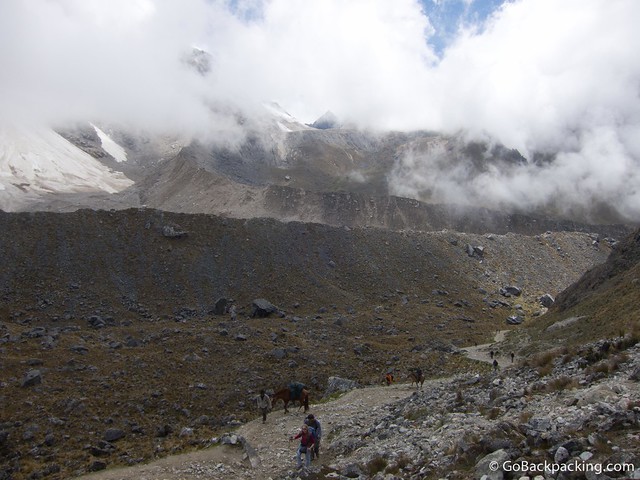
The closer we got to the 4,650-meter mountain pass, the more energized I felt. I surprised myself in the best possible way.
The landscape had changed dramatically in the 750 meters we'd climbed in elevation.
Gone were the green grasses, replaced by the rocky, moon-like landscapes often seen above 4,000 meters.
On Day 1, we practically had the trail to ourselves aside from a couple trekking with a guide.
On Day 2, we shared the trail with that couple and another small group of trekkers.
The lack of other people was a surprise and a clear benefit to trekking in the low season.

Euphoria struck us all as we posed by the sign marking the high point of the trail.
It was a new personal high for me in terms of trekking at high altitudes, though I'd previously been as high as 5,000 meters during the visit to Pastoruri Glacier.
Maybe it was the thin air, but I felt I had the energy to go even higher. After three and a half hours of walking up to the pass, I knew I could've gone even higher that day.
But the most challenging part of the day wasn't going up; it was the following five hours it took to descend 1,750 meters in elevation.
After about 20 minutes of rest and picture-taking at the pass, we began our descent.
Driven by a desire to get to a lower elevation to negate the ill effects of the altitude, I walked as quickly as my body would take me.
My knees didn't appreciate that approach, and within a few hours, I was starting to feel sharp pangs of pain.

At an elevation of 4,000 meters in a verdant green valley, we stopped for a spaghetti lunch at the small village of Huayracpampa.
It was here that we found the Japanese guy sleeping on our bags, which had been unloaded from the horses upon arrival (ahead of us).
The last 3 hours of walking were the killer. Physically, the most challenging part of the trek for me. I slowed my pace and adjusted the way I walked on the steeper bits.
The whole trail was scree and loose rock, like a dry riverbed. I wanted nothing more than to get to Camp 2, so I could lay down and rest.
I began repeating a mantra, “you can walk slowly, but you must keep walking.”
When we finally arrived in Chaullay and removed my shoes and socks, I was greeted by 4-5 painful blisters on each foot.
I usually carry a sewing needle so I can drain them, but I'd forgotten. Luckily, the German girl had one to spare.
Dinner was a relaxed affair, and I went straight to sleep after it was over.
Day 3 – Chaullay to Santa Teresa
Begin: 2,900 m / 9,514 ft; End: 1,900 m / 6,234 ft
Change in Elevation: –1,000 m / 3,281 ft
Time walking: 4 hours 15 minutes
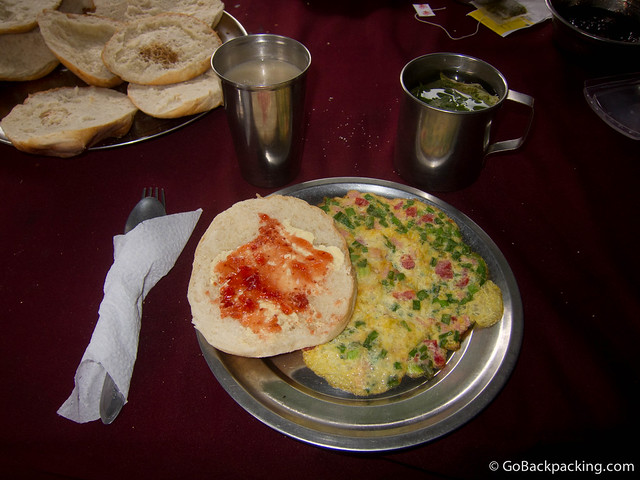
It rained at some point during our second night as we awoke to wet tents. However, I slept like a log.
Even though we were 1,000 meters lower than the first night, the temperatures were far warmer than we'd experienced at Camp 1.
Rising around 6 AM to coca tea delivered to our tents, we had a filling breakfast, said goodbye to our horseman and horses, and began walking along a dirt road that follows the Lluskamayu River.
A recent landslide had taken out a section of the regular hiking trail, which runs on the opposite side of the river, so we took a detour for safety reasons.

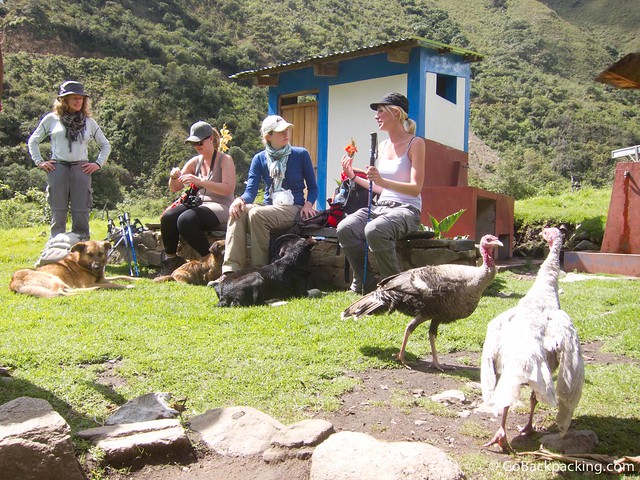
Reinvigorated after a whole night's rest, I lead the pack. Compared to the first two days of walking, Day 3 was a breeze.
We followed the river for the entire day's walk. As we descended in elevation and the sun rose higher in the sky, it became very hot and humid.
I found myself walking quickly simply because I wanted to reach our camp for the night. I wanted to escape the heat.
It didn't take long for my knees to reject this strategy. Once again, I was feeling sharp, at times crippling, pains in my knees.

We were able to detour around one massive landslide that affected the trail, but others still required we pass them. It helps if you don't look down.
A little over four hours after we got started, we reached the end of the trail.
A minivan was waiting to take us the short distance to the village of Sahuayacu (elev: 2,520 meters), where we had a gigantic lunch of soup, fried rice, and vegetables.
We then hopped back into the van to drive to nearby Santa Teresa, where we would be spending our third night.

The reward for getting this far was a dip in the hot springs outside Santa Teresa.
They're situated in a scenic spot alongside the river, and we arrived before the other groups doing the Inca Trail and Inca Jungle treks.
For 10-15 minutes, aside from a few locals, we had the pools to ourselves.
That night we were to have a campfire. However, heavy rain washed those plans away. Instead, we drank beer and played a few rounds of asshole after dinner.
Day 4 – Santa Teresa to Aguas Calientes
Begin: 1,900 m / 6,562 ft End: 2,000 m / ft
Change in Elevation: -100 m / 328 ft
Time walking: 3 hours
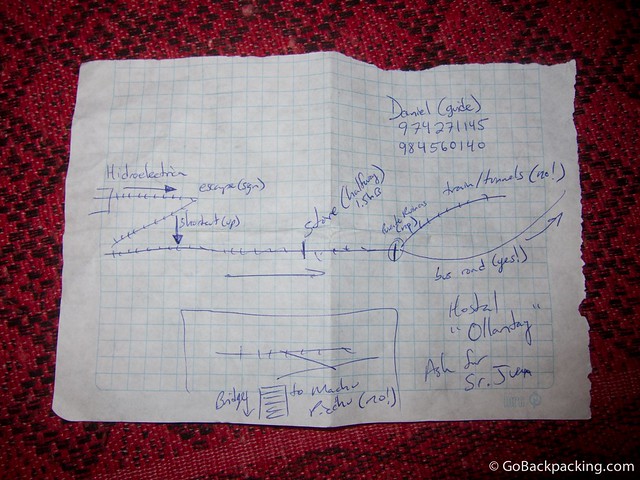
On the fourth morning, the group split up.
I wanted to head straight for Aguas Calientes, as did Nicole (Canada), while the rest of the group wanted to pay about $30 to ride what's billed as South America's biggest zipline.
Daniel drew Nicole and me a map from the Hydroelectric plant to Aguas Calientes. It was as if we were in Stand by Me.
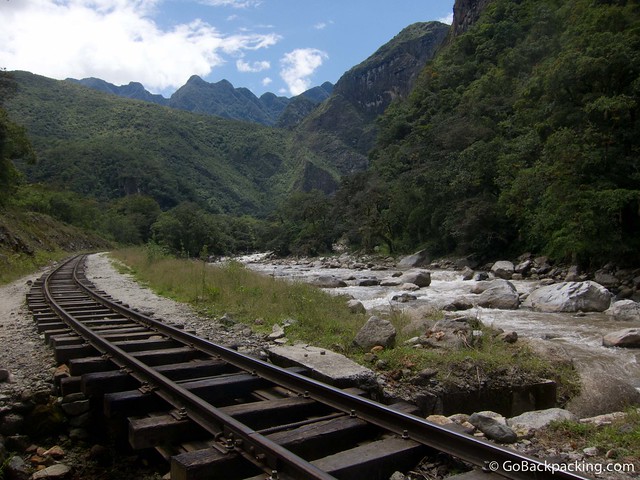
Nicole and I took a 30-minute taxi, along with an Argentinian trekker, to the start of the railway that runs from the Hydroelectric plant through Aguas Calientes and Ollantaytambo to Cusco.
There were still sections where we had to walk on the loose rock of the railroad tracks. However, it was a very flat walk through the valley that runs up behind Machu Picchu.
Along the way, a dog began to follow us. Daniel informed us that the trains pass every hour or two, and sure enough, we had to step aside for one during the 3-hour walk.
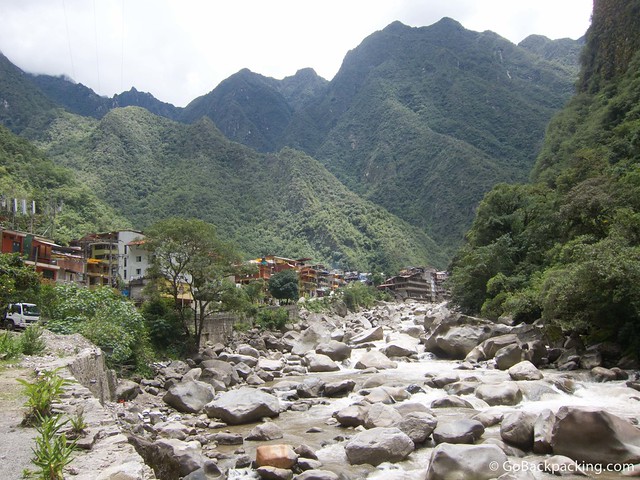
When we reached the entrance to Machu Picchu, near the train tracks, Nicole and I posed for pics since we'd be getting up before dawn the next day for the hike up.
With a mix of excitement and relief, we finally walked up to the road that runs from Machu Picchu's main entrance to the town of Aguas Calientes.
Situated along the river, with the train tracks running straight through the center, it's a tourist town in the strictest sense of the term.
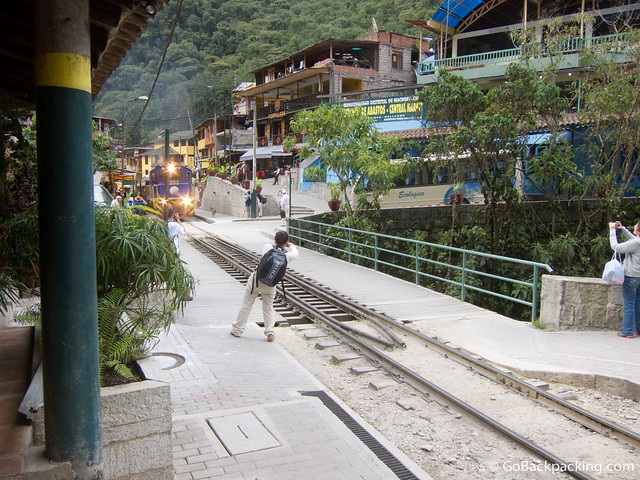
Upon finding our hostel for the night, I showered and treated myself to a one-hour massage, followed by coffee and a piece of rich chocolate cake. Dear civilization, I missed you!
That night, we had a group dinner at one of the restaurants. We all ordered the trucha (trout), a dish I've come to relish when up in the Andes.
After dinner, a few of us went for a cocktail — five for one caipirinha, which drew us in the door.
Unfortunately, they were the tiniest cocktails I'd ever been served. And oh yeah, we forgot about the inevitable tax and service charge they'd tack on.
Small drinks aside, it was nice to spend a little time bonding before we set off for our final destination, Machu Picchu and Wayna Picchu, before dawn the following day.
***
Dave's 160-page, all-original Lima Travel Guide is available for Kindle.
Dave is the Founder and Editor in Chief of Go Backpacking and Feastio. He's been to 66 countries and lived in Colombia and Peru. Read the full story of how he became a travel blogger.
Planning a trip? Go Backpacking recommends:
- G Adventures for small group tours.
- Hostelworld for booking hostels.

amedinajordan
Thursday 12th of May 2016
Dear Dave,
I'm planning to be in Cusco with a group of 3 people (including me) in early August. I've seen your recommendation above for waiting until arriving at Cusco in order to book a tour for the Salkantay trail. Given that most of the comments above are from 2012, would you still recommend / is it still advisable to wait until arriving at Cusco to book the tour of the Salkantay trail with a local group?
Graham
Tuesday 5th of April 2016
Hi Dave What a great blog & all info highly informative! I have organised a group of 10 50ty+ somethings to do a slightly longer 7day/6 night Salkankay trek. Most of us have treked in Nepal and some have also climbed Mt Kilimanjaro in the past so hopefully know what to expect altitude wise, although you never really know how it will hit you.
We leave in a couple of week's time so not long to go!
My question concerns tipping, & while I know this is entirely optional I am trying to get a feel for what I need to tell my group to expect, but from reviewing loads of web sites I get vastly different rates. Do you have any advice on the subject?
Thanks.
Dave
Tuesday 5th of April 2016
Hi Graham,
Thanks! On this trek, I found that people varied widely in how much they tipped, and it usually broke along cultural lines. Some Europeans not use to tipping tipped less, while I try to tip more generously because I know guides, cooks, and porters leading super budget trips like these are often paid very little.
My advice is to not worry so much about what others are tipping, and base it on what you feel is appropriate for the support and service provided. I know that's not the definitive answer you were seeking, but I think you could ask people from five different countries and receive 5 different answers.
Sam
Tuesday 5th of January 2016
Hello!! I know this is out of date but I stumbled upon this blog post as I was researching for Salkantay. I'm planning on going in May!! And silly stupid girl question, but are there showers available wherever you are stopped for the night? If so, is there hot water? Or does everyone go the whole 4 days without showering? Thanks!
Dave
Tuesday 5th of January 2016
There were definitely no showers the first night, and I don't think we had them the second night either. I can't recall the third night, but we did have showers with hot water the fourth and final night as that was spent in the town of Aguas Calientes.
I believe there were Western-style, sit-down toilets everywhere we slept as well, though I don't remember their condition :)
Rohan
Wednesday 5th of November 2014
Hi Dave,
This is a really good post so thank you...Im flying to peru tomorrow and will be in cusco on the 16th. I had 2 quick questions i was really hoping to get your inputs on
a)if you have luggage, how do you mange on the trek? is there someone to assist or can we leave it at one of the hotels?
b) what are the restrooms/toilets like on the salkantay trek?
thanks very much for your time and i look forward to hearing from you
Dave
Wednesday 5th of November 2014
The hostels and hotels can store your luggage while you're on the trek.
The toilet question is a test of my memory. I want to say that there were sit-down toilets available at every place we spent the night. On the actual trail, you'd be left to Mother Nature.
Monika
Thursday 4th of September 2014
Dave, your story here was the one that finally convinced to go on Salkantay trek. Thanks a lot again! My story is here: http://amusedobserver.com/en/4-day-trek-to-machu-picchu-salkantay-trek/